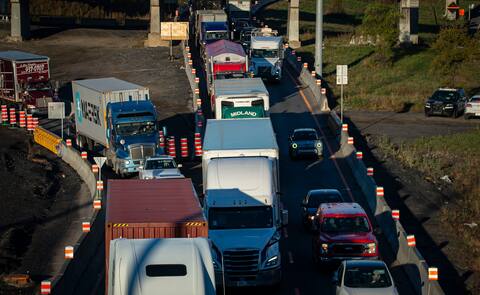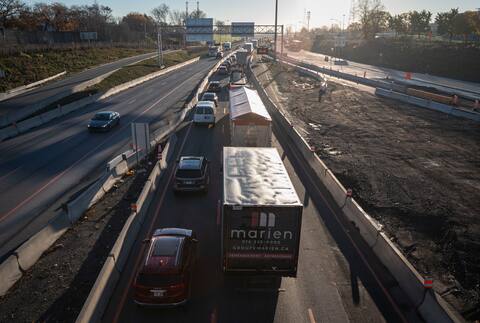Quebec has not estimated the costs of road congestion for the L.-H.-La Fontaine tunnel work, which will not end before 2025 and which will cause major traffic jams.
• Read also: The hell of the works overflows far in the east of Montreal
• Read also: Tunnel: A ramp that wastes a lot of time
• Read also: Works at the bridge-tunnel: “a good practice” according to Plante
The costs of traffic congestion include greenhouse gas (GHG) emissions and other pollutants emitted in traffic jams. Added to this are the costs associated with motorists being late for work, wasted gasoline or accelerated vehicle wear (tires and repairs), in particular.
- Listen to the Dutrizac-Dumont meeting broadcast live every day at 7 a.m. on QUB-radio:
“The Ministry (of Transport) has not made this assessment”, indicates its spokesperson, Gilles Payer.
According to him, GHG emissions will depend on people’s “response” to the various “plan Bs” available to them, including public transport or telecommuting. The government says it is investing more than $150 million in traffic congestion mitigation measures.
The ministry adds that it has been working for “several years” to integrate these measures.
Photo QMI Agency, Thierry Laforce
Figures of… 2008
Over the years, studies have assessed the costs of road congestion in the metropolis. The latest available estimates date from 2018 and are included in a report by LesAdvisors ADEC produced for the City of Laval. In this report, the total costs were estimated at $4.2 billion.
This report actually establishes an estimate based on an assessment by the same company carried out in 2014 for the Ministère des Transports du Québec (MTQ), but with data from 2008. At the time, congestion was assessed at 1, $8 billion, and Montreal took more than half of the pie.
These studies do not detail the impacts for each infrastructure.
In the past, the MTQ carried out a study on the costs of congestion every five years. By comparing the 1993 data with that of 2018, it is calculated that the costs of congestion in the Montreal region have increased by more than 500%.
Photo QMI Agency, Thierry Laforce
“We do not want to know”
“The methodology is improving from year to year, which may explain some discrepancies, but the trend is clearly upwards, and it is growing much faster than GDP,” explains the Log the president of Les Conseils ADEC, Gilles Joubert, who has since become Gilles Joubert, Conseils.
“It’s normal, there is no new infrastructure being built, and public transport projects have been delayed. So it’s not subject to improvement,” he adds.
Mr. Joubert deplores that the latest precise data dates from 2008.
“There doesn’t seem to be an appetite for the new reality of congestion and especially the costs […] maybe we don’t want to know, he said. It surprises me and saddens me a little.
The objective of carbon neutrality is maintained
Even if the works of the Louis-Hyppolite La Fontaine tunnel are much larger than expected, the Ministry of Transport assures that the site will be carbon neutral
That is, trees will be planted or carbon credits purchased to offset the greenhouse gases (GHGs) emitted during construction.
Car traffic and congestion are not included in this calculation and continue to represent a very real source of pollution.
The tunnel construction site is one of seven carbon-neutral projects planned by the ministry.
To date, only the Turcot interchange worksite has been carbon neutral in Quebec.
“Since work began 18 months ago, [le consortium responsable] RLF has counted 4,500 tons of CO2 equivalent,” explains Gilles Payer, spokesperson for the ministry.
This is the GHG equivalent of around 2000 cars over a year.
To plant trees
To offset these emissions, it would already be necessary to plant around 31,500 trees, according to an offset calculator from the Carbone boréal research team at the University of Quebec at Chicoutimi. The consortium could also buy carbon credits from a green project.
“If the construction site lasts longer, which will be the case, then the compensation will simply be adjusted accordingly”, specifies Mr. Payer.
However, offsetting GHGs is more complicated than it seems.
As demonstrated The newspaper last year, the carbon neutrality of the Turcot interchange was problematic.
100 years to compensate
It will take a century for the 51,000 trees planted or soon to be planted to actually offset the emissions emitted during the work.
In theory, carbon credits contribute to the reduction of GHGs, because they are purchased from projects that produce renewable energies, such as a wind farm, for example.
However, in the case of the Turcot interchange, most of the compensation was made by purchasing credits from a hydroelectric power plant project in India which caused several environmental damages, revealed The newspaper.



